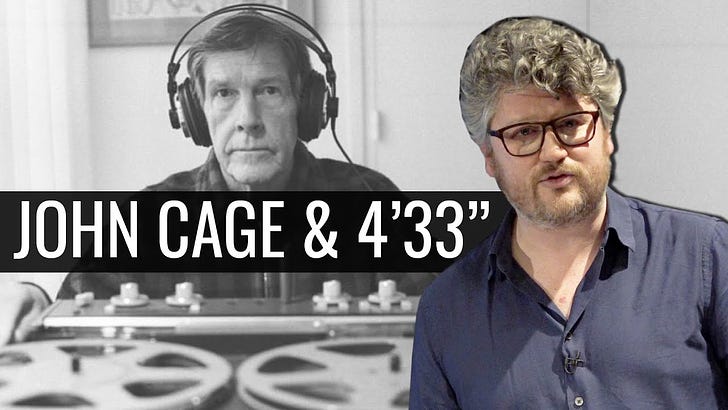"Music Made of Listening"
An extra beat on "open-earedness" — and what it means to "simply listen."
Just after I finished last week’s post on being more “open-eared” — that is, being more adventurous and curious about unfamiliar music — I came across this video while doing some unrelated research.
But it turns out it is related, so I’m sharing it with you today.
(An aside: The “open-eared” post got quite a bit of response, and if you haven’t looked at the comments, I recommend it — lots of great ideas for adventurous listening! Later this week I’ll have a subscriber-only post attempting to sketch my own listening practices and rituals. After that I’ll turn back to other subjects, so this doesn’t suddenly become a music newsletter. But people really responded to that post and I heard you.)
Today’s sequel is more, well, adventurous. It’s about listening to the music of no music.
The short version: I was looking up a fact about John Cage’s famous piece 4’33” — which consists of not playing the piano for four minutes and thirty-three seconds; this inspired an exercise in the TAoN book, mentioned in this earlier post — and came upon this 2019 lecture by Tom Service, a professor of music at Gresham College in the UK. I was intrigued by the title — “Music Made of Listening” — and enjoyed the talk.
Service starts with the point that Cage’s famous “silent” piece made: There is no silence. There can be “collective quiet,” but as the audiences for 4’33” have discovered, sound continues even in a music hall where the musician isn’t playing.
This basic idea is familiar to me (and I’m sure to many of you) but Service’s talk had some fun and original details. My favorite: “Stella le Silence” — a 1967 French pop tune in which the chorus, in effect, is a moment of silence. It’s like a sample of 4’33”!
That alone made the talk worthwhile to me! But Service goes on to make some useful points about how great musicians are great listeners — and in effect that listening can be a creative act. His talk ends with a brief conversation with composer Rolf Hind, and a Pauline Oliveros prompt that brings home the connection.
Keep reading with a 7-day free trial
Subscribe to The Art of Noticing to keep reading this post and get 7 days of free access to the full post archives.


